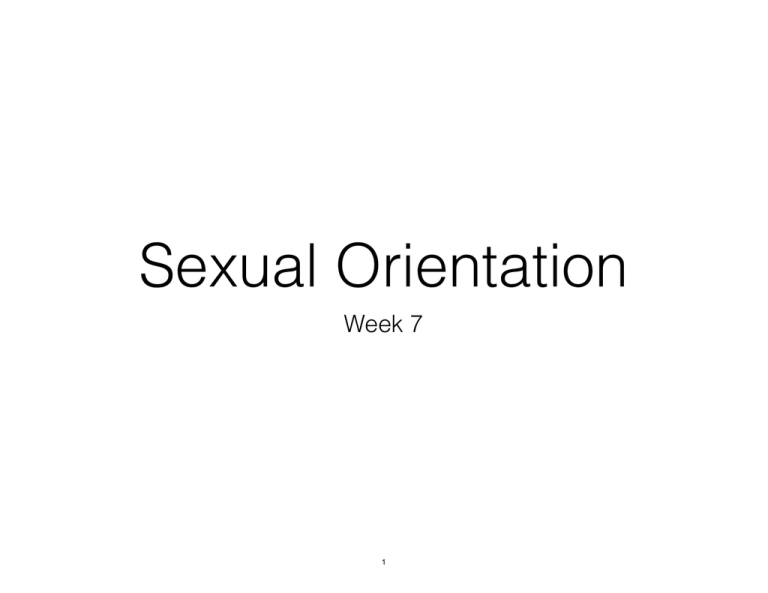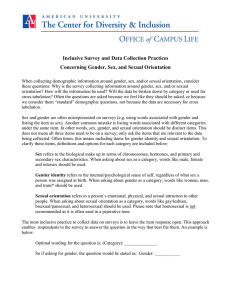
Sexual Orientation
Week 7
1
Objectives
1. Describe research methods for studying health
across sexual orientation
2. Identify some key sexual orientiaton-related health
disparities
2
Sexual Orientation Dimensions
Behaviors
(sex/gender of
sexual
partners)
Identity
(“heterosexual,”
“bisexual,” etc)
Attractions
(attracted to males,
male and females, etc)
Each dimension represents different exposures, lived experience, pathways to health outcomes
3
Dimension 1: Sexual Orientation Identity
How might sexual orientation identity be linked to
health?
•
Exposure to discrimination/victimization, rejection
by family/community
•
Alternatively, immersion in communities with
distinct social norms, social networks
•
Norms may be good or bad for health
4
Dimension 2: Sexual Orientation Identity
How might sex of sexual partners be linked to health? •
STI transmission differs by sex of partner
•
STI prevalence in sexual network
How might gender of sexual partners be linked to
health?
•
Gendered power inequities
•
Gendered expectations of role in sexual encounters 5
Dimension 3: Sexual Attractions
How might same-sex sexual attractions be linked to
health?
•
Psychosocial impact of stigmatized feelings
•
Even without one’s attractions being known to
others
6
Sexual Orientation by Gender
16
14
12
10
%
Women
Men
8
6
4
2
0
Same-Sex
Attraction
Same-Sex
Partners
(Lifetime)
Same-Sex
Partners
(Past Year)
7
Bisexual
Lesbian/Gay
Mosher et al NSFG Data 2002
5%
4%
3%
Women
2%
Men
1%
0%
19
88
19
89
19
90
19
91
19
92
19
93
19
94
19
96
19
98
20
00
20
02
% w/ Same-Sex
Partners
Historical Changes in Those Reporting Same-Sex Partners by Gender
Year
8
Butler Social Forces 2005
Study Population
•
•
NHSII women consented for children
•
9-14 years old in 1996 (N=16,882)
•
10-17 years old in 2004 (N=10,923)
Created new longitudinal cohorts
•
•
Growing Up Today Study (GUTS) 1 & 2
Annual questionnaires
9
GUTS Sexual Orientation Assessment
Taps two dimensions of orientation
•
Sexual orientation identity
•
Attraction Adapted from Remafedi et al. (1992) •
Minnesota Adolescent Health Survey Included on GUTS since 1999 & ongoing •
Repeated measures on multiple waves
10
GUTS Sexual Orientation Assessment
Which one of the following best describes your feelings
•
Completely heterosexual (attracted to persons of the opposite sex)
•
Mostly heterosexual
•
Bisexual (equally attracted to men and women)
•
Mostly homosexual
•
Completely homosexual (gay/lesbian, attracted to persons of the
same sex)
•
Not sure
11
Emergence of Sexual Orientation Over Time: Females
12
10
Comp Het
Mostly Het
Bisexual
Mostly Homo
Comp Homo
Unsure
8
%
6
4
2
0
12
13
14
15
16
17
18
19
20
21
22
Age in Years
12
Ott et al J Sex Res 2010
Emergence of Sexual Orientation Over Time: Males
12
10
Comp Het
Mostly Het
Bisexual
Mostly Homo
Comp Homo
Unsure
8
%
6
4
2
0
13
Ott et al J Sex Res 2010
Sexual Orientation Health Disparities
Observed for many outcomes
•
BMI/overweight
•
Eating disorder behaviors
•
Substance use
•
Many more
Significant sex/gender-by-orientation interactions
•
Patterns vary by outcome and developmental period
14
Sexual Orientation Assessment
Identity
Behaviors
Attractions
GUTS Categories Completely heterosexual NHS2 Categories Heterosexual Completely heterosexual with same-sex partners Bisexual Mostly heterosexual
Lesbian Bisexual Lesbian
15
Sexual Behavior
Compared to heterosexuals, bisexual and lesbian
females are:
1. As likely to have sex with:
A. Men
2. More likely to have sex:
B. At a younger age
C. With more partners
16
Charlton et al J Adolesc Health 2010
Gynecologic Care
17
Odds
Ratio
% STI diagnosis
in Lifetime
Sexually Transmitted Infections 11
22
8
Completely
Heterosexual
Mostly
Heterosexual/
Bisexual
Lesbian
Ref.
2.00
N/A
18
Charlton et al J Adolesc Health 2010
Odds
Ratio
% Pap Test in Last Year
Pap Testing
88
84
70
Completely
Heterosexual
Mostly
Heterosexual/
Bisexual
Lesbian
Ref.
0.73
0.25
19
Charlton et al J Adolesc Health 2010
Gynecologic Care Mediators
% Pap Test in Last Year
66% variable y
33% variable x
88
70
Completely
Heterosexual
Lesbian
20
Charlton et al Am J Public Health 2014
% Pap Test in Last Year
Gynecologic Care Mediators
36% hormonal contraceptive use
88
70
Completely
Heterosexual
Lesbian
21
Charlton et al Am J Public Health 2014
HPV Vaccination
22
% Received ≥1 Dose
HPV Vaccination
56
8
Females
Males
Special attention is needed among boys and men, especially those males who do not identify as gay. 23
Charlton et al In Preparation (abstract: Am J Epidemiol 2015)
HPV Vaccination
HPV vaccination (≥1 dose) by sexual orientation among males Completely Heterosexual
0.46 (0.30-0.68)
Mostly Heterosexual
0.44 (0.25-0.78)
Gay
ref.
1.0
Risk Ratio
24
Charlton et al In Preparation (abstract: Am J Epidemiol 2015)
Teen Pregnancy
25
Risk
Ratio
% Pregnant
Increased Teen Pregnancy
2
9
4
3
Completely Completely Mostly Heterosexual Heterosexual Heterosexual/ w/ Same-Sex Bisexual Partners
Ref.
5.82
2.28
Lesbian 1.61
26
Charlton et al Am J Obstet Gynecol 2013
Potential Risk Factors
1. Gender expression/conformity
2. Identity-related stress
3. Bullying
4. Childhood abuse
5. Sexual orientation disclosure
6. LGB community involvement
7. Developmental milestones
Disparity driven by established risk factors, rather than unique
risk factors
27
Charlton et al In Preparation (abstract: J Adolesc Health 2015)
Further Risk Factors
Upcoming qualitative work
1. Family composition
2. Pregnancies, abortions, contraceptive use
3. Sexual history, sexual orientation
4. Abuse
5. Stigma
6. Discrimination
28
Maternal Attitudes
29
Maternal Attitudes Assessment
•
Attitudes and behaviors around Pap tests and HPV vaccines
•
•
Acceptance of diverse sexual orientations
•
•
A number of sexual orientation-related differences (e.g.,
mothers of LGB participants more likely to intend to
vaccinate)
Mothers of LGB participants were more accepting
Maternal-child relationship quality
•
Mothers of LGB participants and their child were more likely
to both report low relationship quality
30
Maternal Attitudes Predicting Daughter’s Reproductive Health
•
Some maternal attitudes and behaviors around Pap tests
and HPV vaccines (e.g., intention to vaccinate daughter)
predicted daughter’s improved reproductive healthcare
(e.g., daughter’s Pap test and HPV vaccination)
•
More acceptance of diverse sexual orientations predicted
daughter’s improved reproductive healthcare
•
Maternal-child relationship quality less consistently
predictive
•
Next step: Examine mediation (e.g., sexual orientation
differences)
31
Charlton et al In Preparation (abstract: J Adolesc Health 2016)
Public Policy
32
Law and Policy
30% more likely to change from heterosexual to any sexual minority if living in state with same-sex marriage laws
33
Charlton et al Under Review (abstract: Ann Behav Med 2013)
© Brittany M. Charlton 2016 34
MIT OpenCourseWare
http://ocw.mit.edu
WGS.151 Gender, Health, and Society
Spring 2016
For information about citing these materials or our Terms of Use, visit: http://ocw.mit.edu/terms.





